the Ficticious Island Santa Lemusa
Neuste Beiträge
- Eine Premiere in Weimar: die Kisten der Kukaldaria
- Bericht aus Raum Nummer 8: Miso
- Diese gehackte Hühnerleber ist einer Hexe gewidmet
- Marrokos goldene Königin - die Salzzitrone
- Revidierter Klassiker aus Syrien: Tabouleh
- Ein Dip vom Kap Domèn: Kawotaise – aus Karotten und Süsskartoffeln
- Fuss vom Schwein, im eigenen Gelee gefangen: Pieds de porc St-Antoine
- Um ein Haar wärs ein Palast geworden: Panais royal
- Aus Sehnah: Brotsuppe mit Hühnerherzen
- Salzig uminterpretiert: Bananenschaum mit Seehasenrogen
- Ergiebig uns schön: Terrine aus dem Kopf eines Spanferkels
- Ein überraschender Apéro-Snack: Oliven auf senegalesische Art
- Was wäre Asien ohne die Rote Bohnenpaste
- Senegals Nationalgericht Thiéboudienne
HOIO und Cookuk
- Das Tagebuch von Raum Nummer 8 (Susanne Vögeli und Jules Rifke)
- HOIO-Rezepte in der Kochschule – das andere Tagebuch
- Immer ein Experiment wert: Vakuum-Fermentation (Grundrezept)
- Überholter Klassiker – Boeuf à la mode d'aujourd'hui
- Viel Geschichte, viel Gelatine – Bœuf à la mode (Rinderschulter mit Karotten)
- Klassiker aus Korea – mit modernen Mitteln hergestellt: Kimchi – im Vakuum fermentiert
- Die Salzgurke – ein Klassiker aus dem Königreich der Milchsäuregärung
- Wundersame Transformation im Beutel: milchsauer vergorene Spargeln
Etwas ältere Beiträge
- Pfeffrige Suppe aus Singapur: Bak kut teh
- Rauchzeichen von Trobriand-Inseln: «Mona» – ein Taro-Dessert
- Leichte Kost mit Gewicht: Taschenkrebs im Sud gekocht
- Aus Singapur: Hokkien hae mee, Nudeln mit Garnelen
- Alles mit «P»: Peter Polters Peterli-Pastinaken
- Wärmendes aus Tocantins: Caldo de Chambari
- Osmanische Kuttelfreuden, im Handumdrehen zubereitet: İşkembe Çorbası
- Zwischen Nase und Schwanz: Kaninchen-Innereien auf Knollensellerie
- Ein sensorisches Erlebnis schönster Art: Xiǎolóngbāo – Teigtaschen aus Shanghai
- Ein vegetabiles Gehirn aus Lyon: Cervelle de Canut – Frischkäse mit Kräutern und Gewürzen
- Im Namen von Laozi: Zwetschgeneis mit Ingwer
- Schnelle Erfrischung für warme Sommerabende: Melonenkaltschale mit Buttermilch und Minze
- Selbst gemacht ein würziges Küchenkunststück: Dresdner Sauerbraten
- Der kasachische Klassiker Beşbarmak wird am besten mit den Fingern zum Mund geführt
- Gilt als das Nationalgericht von Kasachstan: Kuurdak – ein Eintopf aus verschiedenen Innereien vom Rind
- Kaum ein anderes Gericht ist im Osten von Kasachstan so populär wie Laghman (Лагман), ein Gemüseragout mit Nudeln und wenig Fleisch
- Aus der Nachbarschaft von Milano Centrale stammt diese Lattichsuppe mit Taleggio
- Aus La Puiguignau stammt die blumige Gewürzmischung «Sourire», bei der Entsteheung auch Paul Gaugin seine Finger mit im Spiel hatte
- Eine sehr leichte, feine und würzige Suppe mit ein bisschen Fisch: S'ngao chrouk trey – ein Rezept aus der Khmer-Küche
- Passt zu Fleisch oder Klebreis – Jeow Som, ein säuerlich-scharfer Dip aus dem nördlichen Laos
- Fürchterlich altmodisch und einlullend aromatisch: Choux de Bruxelles à la crème nach Ali Bab
- Ein kulinarisches Monument aus den sechziger und siebziger Jahren: Chicken Kiev
- Nicht aus Russland, sondern aus der Ukraine: Borschtsch wärmt auch als vegetarische Suppe
- Ein west-östlicher Wickel aus Mallorca: Llom amb col – Schweinelende in Wirsing
- Ein Klassiker aus der Lombardei: Trippa alla milanese – eine Kuttelsuppe mit Saubohnen
Grosse Projekte
- 2002 - Einweihung der mobilen Boutik von HOIO in Genf
- 2003 - «Autorretratos» – Inszenierungen in Santa Lemusa und Buenos Aires
- 2004 - «Waiting Room» im Kunsthaus Baselland
- 2005 - Das Geheimnis einer Spalte auf der Älggi Alp
- 2006 - «It's only Beluga» - ein kulinarisches Alphabet
- 2007 - Einweihung des Handwagens von HOIO in Ivry su Seine
- 2008 - Geheimagent Hektor Maille bricht zu seiner mehrjährigen «Mission Kaki» auf
- 2010 - HOIO stellt seine globale Gewürzmischung «World No 1» vor, zunächst in Kinshasa
- 2011 - Salon de Lecture in der Kunsthalle Mulhouse
- 2012 - Im Rahmen des Projekts «44/33» taucht Santa Lemusa im Stadtspital Triemli auf
- 2012 - In Riehen bricht ein Papierboot auf zu seiner Reise nach Santa Lemusa
Mundstücke
- Ahornsirup
- Anis
- Apfel
- Aprikose
- Artischocke
- Aubergine
- Banane
- Bauch vom Schwein
- Blumenkohl
- Brust vom Huhn
- Chili
- Fenchel
- Fuss vom Schwein
- Gewürznelke
- Gurke
- Herz vom Rind
- Kapern
- Karotte
- Kombu
- Kopf vom Schwein
- Koriander
- Kubebenpfeffer
- Kutteln vom Rind
- Kürbis
- Leber vom Lamm
- Limette
- Lorbeer
- Lunge vom Lamm
- Magen vom Huhn
- Majoran
- Mangold
- Maniok
- Melone
- Muskat
- Nigella
- Olivenöl
- Pastinake
- Perilla
- Petersilie
- Pfeffer
- Rhabarber
- Rosenkohl
- Rotkohl
- Rotwein
- Salz
- Schwarzer Kardamom
- Schwarzwurzel
- Seeigel
- Sichuanpfeffer
- Spargel
- Stangensellerie
- Taschenkrebs
- Tiger-Fugu
- Tomate
- Zimt
- Zitrone
- Zucchini
- Zunge vom Rind
- Zwetschge
Gewürze aus Santa Lemusa
- Anis «Désir de Tikk»
- Chili «Krot Kriket»
- Chili «Papok»
- Chili «Piment Cancan»
- Fenchel «Fnui de Castebar»
- Gewürznelke «Bourdons d'Ejac»
- Kardamom «Kap de la Bandole»
- Koriandersamen «Kantalil»
- Kreuzkummel «Chera de Sentores»
- Kubebenpfeffer «Cubèbe de Sugiau»
- Kurkuma «Meriti Kochon»
- Lorbeer «Loia d'Askatas»
- Mohn «Grains de Liliac»
- Muskatblüte «Macis Coco»
- Muskatnuss «Miskat Coco»
- Nigella «Mystèr de Maizyé»
- Pfeffer schwarz «Senpuav nwè»
- Pfeffer weiss «Senpuav blan»
- Piment «Mussagor»
- Safran «Crocus Mont Fouet»
- Salz «Neige Bandon»
- Salz geräuchert «Neige Fim»
- Salz grau «Le Noir Stendhal»
- Salz rosa «Le Rouge Stendhal»
- Schw. Kardamom «Queue d'Éléphant»
- Senf schwarzer «Moutad de Maioli»
- Sesam «Sésame Baba»
- Sichuanpf. «Rougeurs de St-Brice»
- Sternanis «Baschi Dao»
- Thymian «Thym de Carbelotte»
- Wacholder «Perles de St-Anne»
- Zimt «Kannèl d'Oscar»
- Zimtkassie «Bois des Brumes»
Abkürzungen
- Grosses Popup-Fenster Karte von Santa Lemusa
- Grosses Popup-Fenster Karte der Hauptstadt Port-Louis
- Sämtliche Gewürze von HOIO: Boutik «Masalee» (Seite im Aufbau)
- Grosses Popup-Fenster Weltkarte Episoda (Mittelpunkt Zürich)
 |
Tonkotsu-Ramen «Bugi»
Milky Pork Soup with Noodles
Tonkotsu-Ramen is an adventure – less because of the porky ingredients it contains than because of the time it requires to cook the milky extract from the bones and the meat: the genesis of the soup can take no less than 24 hours. It might be in order to remember that during this time-span, the earth makes one full revolution on its axis. That's almost a biblical dimensi
«Pork bones»
Tonkotsu-Ramen is a speciality that is eaten with the greatest relish on Japan's southern-most island of Kyūshū – Tonkotsu generally means «pork bones». The soup ranges in colour from pearly white to pale brown, has a creamy consistency and a strong, porky aroma. Whether the soup should cook for 24 hours or for six or just three, as some say, is a matter of debate – as well as the question of the intensity with which the soup should bubble. (General observations on the subject of cooking time and ground rules for the preparation of meat can be found in the chapter «Beef Stock».) Fantasy is allowed to run riot as regards the ingredients of garniture: pork stomach often forms the meat base of the soup, to which bean sprouts or a bit of cooked gherkin are added – as well as some garlic, freshly grated or roasted, sesame, sesame oil, pepper, ginger and, occasionally, candied ginger (Beni shōga) etc.
Recipe for «Ramen Bugi»
When Hektor Maille tasted Tonkotsu-Ramen for the first time in a noodle bar in the east of Gaien Higashi Dōri, he was so captivated by the aroma of the soup that he immediately requested Kyuri, his Japanese-descent instructress in matters of self-defence, to provide him with guidelines for the preparation of the soup. Kyuri sent him a recipe that was originally from one of her friends who was of Osaka-descent and ran a noodle bar called «Ramen Bugi» in Sydney. The recipe provided here has been adapted according to the ingredients available in middle Europe – which is also the reason that we have christened the soup Tonkotsu-Ramen «Bugi». The soup is not a diet food, but it has a fantastic, deeply earthy aroma all its own.
Alternatives
A part from this time-intensive recipe for Tonkotsu-Ramen we are providing on these pages a second recipe as an alternative that can be prepared far more quickly: Noodle Soup «Kyuri» comes from the recipe collection of Hektor Maille's martial arts teacher and is one of the dishes that the secret agent is fond of cooking for himself. This soup comes from Chitwouj.
Ingredients (for 1 L soupe base)
1 kg pork bones
500 g pork trotters
1 pork tail
300 g chicken carcasses (e.g. from a roast chicken you had the day before)
2 medium sized onions
1 bulb garlic
2 tablespoons rapeseed oil
100 g ginger, cleaned (but not pealed) and sliced
poss. 1 carrot, cleaned and sliced
poss. 1 little leek, cleaned and sliced
Ingredients (Topping for 2 persons)
2 tablespoons sesame oil
1 walnut-sized piece ginger, cleaned and finely chopped
3 pods garlic, finely chopped
Ingredients (for 2 big bowls Tonkotsu-Ramen «Bugi»)
1 piece pork belly of about 150 g
2 teaspoon sesame paste (Tahini)
1 tablespoon sesame, finely ground in a mortar
3 pods garlic, pressed
1 or 2 teaspoons salt
½ TL weisser Pfeffer
150 g ramen noodles
50 g mung bean sprouts, washed
2 tablespoons Asiatic spring onions, sliced
Some Shichimi
Preparation of Tonkotsu soup base (the first 22 hours)
- Chop bones, if required, into big chunks.
- Bring water to a boil in a large pan (that can hold at least 6 or 7 litres on the bubble), add bones, pork feet and pork stomach and blanch for 5 to 10 minutes. Drain. Put the meat into a sieve and run cold water over it.
- Put the bones and meat back into the pan and add about 3.5 or 4 litres of water. Bring slowly to a boil, reduce heat and leave the stock to cook lightly on very low heat for about 22 hours (never allow it to boil heavily). As the stock bubbles very lightly, the pan does not need to be closed with a lid. Nevertheless, one has to add a bit of water to the stock from time to time – the bones should never rise above the surface of the liquid in the first 22 hours.
Preparation of Tonkotsu soup base (the last few hours)
- Clean onions and quarter, together with peel. Clean garlic and brake the bulb into pods (without peeling).
- Heat oil in a pan and fry onion and garlic until they are an even brown (the browned particles, products of Maillard-Reaction, lend the soup its distinctive aroma.
- Add onion, garlic and ginger to the stock and cook for about 2 hours. Those who wish to have a more vegetarian flavour can add leek and carrot, for instance, to the stock.
- Add pork stomach pieces (also a later ingredient of the soup) and cook for another hour.
- Remove pan from the stove and allow it to cool a bit. Remove the pork stomach and keep aside for further use. Put the meat and stock into a sieve (best a pointed sieve) and press the water out of the meat firmly (if needed put the meat into the sieve in several stages). Firmly press out the water from the meat, taking care not to press the firm remnants of vegetables etc through the holes of the sieve. One can also tap the rim of the sieve in order to speed up the drainage of the water.
- Allow the stock to get cold. As it cools down, the non-fatty bits of the stock will ossify into a sticky mass because of the gelatine. At the same time the fatty and murky bits will rise to the surface and proceed to form a buttery layer. Now comes the moment of truth: naturally, one can now remove this fatty layer lightly with the help of a spoon. But it is this fat that lends the soup much of its aroma. Be warned, Tonkotsu-Ramen is by no means all lightness.
Preparation of the Topping
- Heat oil lightly in a pan that's as small as possible.
- Fry garlic and ginger in it until they turn dark brown and the oil stops sizzling (this means the water from the spices has evaporated). Keep aside in a separate little bowl to be served along with the soup.
Preparation of the Soup
- Cut pork stomach into 0.5 cm-thick pieces.
- Bring about one-third (about 3 dl) of Tonkotsu soup base to a boil in a pan.
- Mix sesame paste, sesame, garlic, salt and pepper with 2 or 3 dl of water (with a whisk or eggbeater) and stir it all into the soup.
- Just before serving, warm up the pork-stomach bits in the soup for about 3 minutes.
- Cook noodles according to the instructions on the packet and drain (but do not run cold water over them).
- Take two big bowls and put half the noodles into each one. Sprinkle the bean sprouts and the pork-stomach titbits over the noodles. Pour the hot soup over this and garnish with spring onions and a bit of Shichimi. Serve piping hot.
As a tasty alternative after having cooked the pork belly in the soup you can simmer it for about 20 minutes in some soy sauce, Mirin and Sake together with some pieces of ginger, then chop it and add it to the soup.
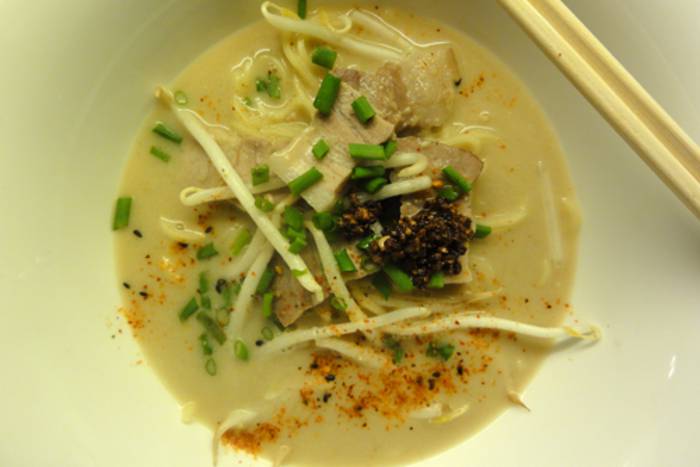 |
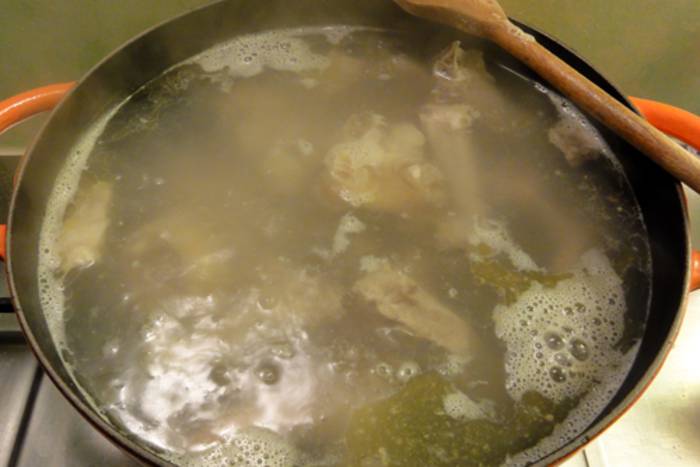 |
 |
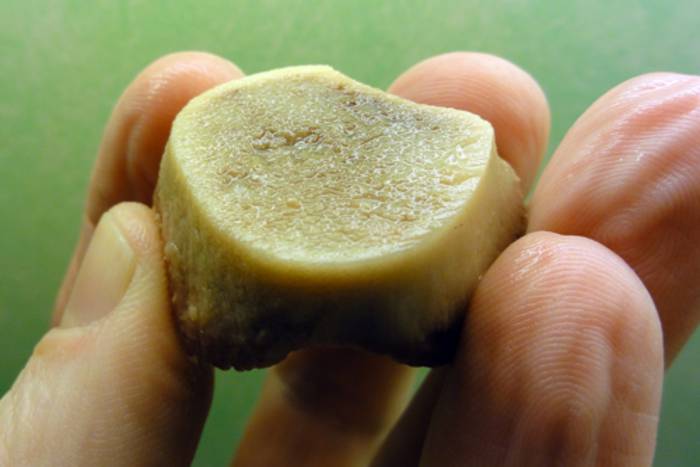 |
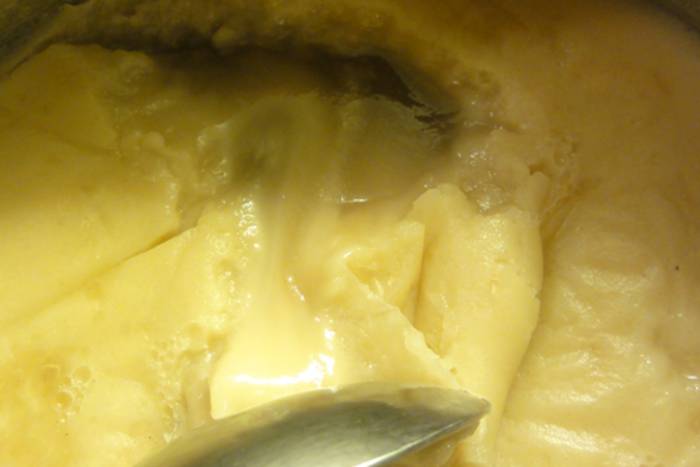 |
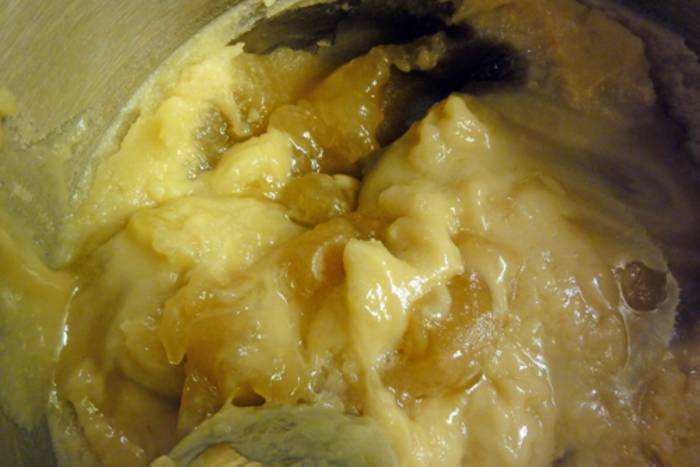 |
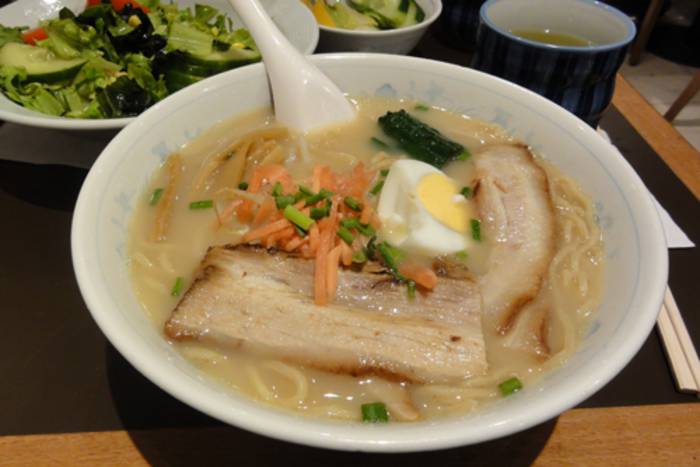 |
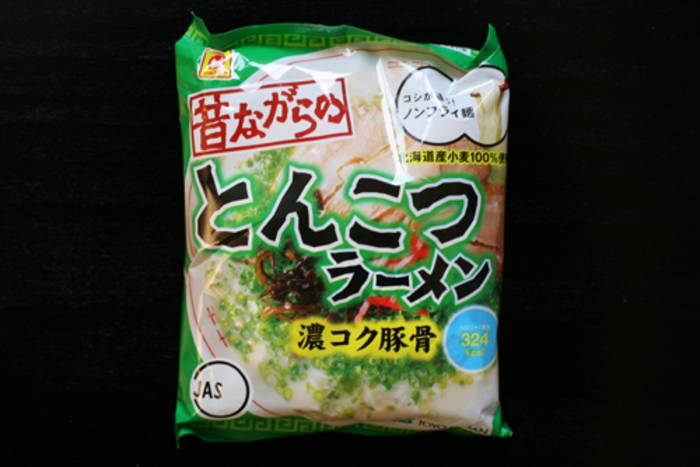 |
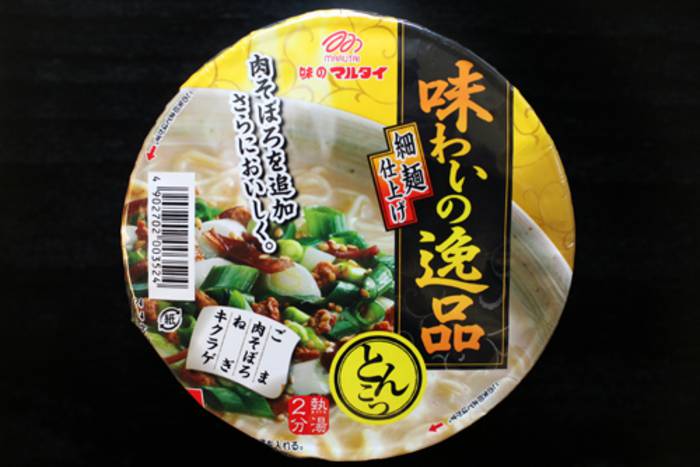 |
More about the travel adventure of Secret Agent Hektor Maille:
- Episode 10: Cherry Blossom Blues in Tokyo
- Startpage of «Mission Kaki» (with overview map)
- More Recipes of the Secret Agent
Japanese restaurants have a few surprises ready for their guests – some are just a tad bizarre, others are, more than anything else, unaffordable. Those who, like Hektor Maille, have stretched their expense account to the hilt, would do well to eat at sushi or noodle bars. Surprising aromas can be found to waft out of a soup bowl in such eating places too:
- Tonkotsu-Ramen «Bugi» (Milky pork bone broth with noodles)
- Noodle Soup «Kyuri» (Soup with noodles, beef and mushroom)
First Publication: 20-5-2010
Modifications: 27-7-2010, 26-1-2011, 19-6-2011, 15-11-2011, 16-12-2011
